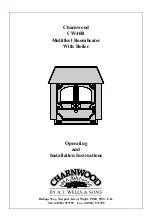
premature failure.
Aerosol spray cleaners should not be
used near the appliance whilst it is
under fire.
If the fire is going to be out of use for
a long period (for instance in the
summer) then to prevent condensa-
tion, and hence corrosion, the
thermostat should be left at the
maximum setting and the main doors
left ajar. It is also advisable to sweep
the chimney and clean out the fire.
After long periods where the fire has
been out of use, the chimney and
appliance flueways should be cleaned
before lighting.
For the fire to operate correctly it is
important that the door seals are in
good condition. Check that they do
not become worn or frayed and
replace them when necessary.
CHIMNEY SWEEPING
The chimney should be swept at least
twice a year. In some installations it
will be possible to sweep the chimney
through the appliance.
First remove the front firebars and
the throat plate. Then sweep the
chimney ensuring that soot is
removed from all horizontal surfaces
after sweeping.
In situations where it is not possible
to sweep through the appliance the
installer will have provided
alternative means, such as a soot
door. After sweeping the chimney the
appliance flue outlet and the flue pipe
connecting the appliance to the
chimney must be cleaned with a flue
brush.
Whilst the fire is out it is a good
opportunity to clean any soot deposits
from the boiler face, and also to
scrape out any soot which may have
collected in the rear throat plate
brackets. A build up of soot in these
brackets will prevent the throat plate
from fitting correctly and can cause it
to fall into the fire.
After clearing any soot from within
the fire, replace the throat plate and
the front firebars.
Different types of sweep’s brushes are
available to suit different flueways.
For standard brick chimneys a wire
centre sweep’s brush fitted with a
guide wheel is recommended. For
prefabricated insulated chimneys the
manufacturers instructions with
regard to sweeping should be
consulted.
TROUBLE SHOOTING
Fire Will Not Burn.
Check that:
a) the air inlet is not obstructed in
any way,
b) chimneys and flueways are clear,
c) a suitable fuel is being used,
d) there is an adequate air supply into
the room,
e) an extractor fan is not fitted in the
same room as the fire.
Fire Blazing Out Of
Control.
Check that:
a) the doors are tightly closed,
b) the thermostat knob is turned
down to the minimum setting,
c) the air inlet damper is closed (at
the bottom left of the appliance), and
that it is not prevented from closing
completely by a piece of ash,
d) a suitable fuel is being used,
e) the door seals are in good
condition.
Fume Emission.
Warning Note: Properly installed
and operated this appliance will not
emit fumes. Occasional fume from
de-ashing and re-fuelling may
occur. Persistent fume emission is
potentially dangerous and must not
be tolerated. If fume emission does
persist then the following
immediate actions should be taken:
A) Open doors and windows to
ventilate the room.
B) Let the fire out and safely
dispose of fuel from the appliance.
C) Check for flue or chimney
blockage, and clean if required.
D) Do not attempt to relight fire
until cause of fume has been
identified, if necessary seek
professional advice.
The most common cause of fume
emission is flueway or chimney
blockage. For your own safety these
must be kept clean.
Freezing
Do not light the fire if there is any
possibility that any parts of the
system may be frozen.
Chimney Fires.
If the chimney is thoroughly and
regularly swept, chimney fires should
not occur. However, if a chimney fire
does occur turn the control knob to
the minimum setting, and tightly
close the doors of the appliance. This
should cause the chimney fire to go
out in which case the control should
be kept at the minimum setting until
the fire in the appliance has gone out.
The chimney and flueways should
then be cleaned. If the chimney fire
does not go out when the above
action is taken then the fire brigade
should be called immediately.
After a chimney fire the chimney
should be carefully examined for any
damage. Expert advice should be
sought if necessary.
Page 6
CW40B 3/95




























